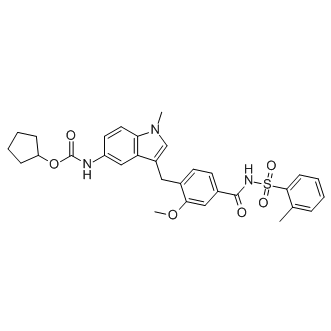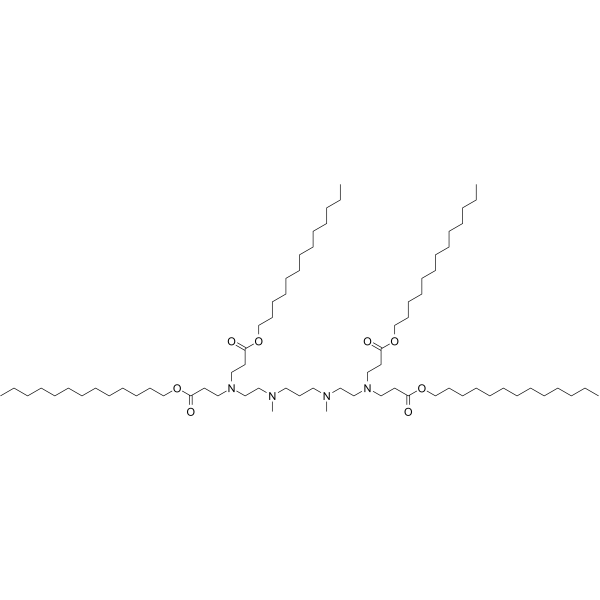 To enhance service speed and avoid tariff delays, we've opened a US warehouse. All US orders ship directly from our US facility.
To enhance service speed and avoid tariff delays, we've opened a US warehouse. All US orders ship directly from our US facility.
| Cat. No. | Product Name | Field of Application | Chemical Structure |
|---|---|---|---|
| DC9762 | Emricasan Featured |
Emricasan (IDN-6556, PF-03491390) is a potent irreversible pan-caspase inhibitor.
More description
|

|
| DC23075 | Vinorelbine Featured |
Vinorelbine is a semi-synthetic Vinca alkaloid which is currently used in treatment of different cancer types mainly advanced breast cancer (ABC) and advanced/metastatic non-small cell lung cancer (NSCLC). Vinorelbine-loaded SSM can be developed as a new,
More description
|

|
| DC48260 | Izilendustat Featured |
Izilendustat is a potent inhibitor of prolyl hydroxylase which can stabilize hypoxia inducible factor- 1 alpha (HIF- lα) and hypoxia inducible factor-2 (HIF-2). Izilendustat has the potential for researching diseases that relate to the body’s inmmune response like colitis and other inflammatory bowel diseases (extracted from patent WO2011057115A1 and WO2011057121A1).
More description
|
|
| DC21630 | SCF I2 Featured |
An allosteric, sepecific inhibitor of substrate recognition by the SCFCdc4 ubiquitin ligase with IC50 of 6.2 uM in FP assyas.
More description
|

|
| DC28252 | Seltorexant hydrochloride Featured |
Seltorexant hydrochloride (JNJ-42847922 hydrochloride) is an orally active, high-affinity, and selective OX2R antagonist (pKi values of 8.0 and 8.1 for human and rat OX2R). Seltorexant hydrochloride crosses the blood-brain barrier and quickly occupies OX2R binding sites in the rat brain.
More description
|

|
| DC11212 | NP161 Featured |
NP161 is a potent and selective inhibitor of extracellular TRX (Thioredoxin 1) in vitro with IC50 of 0.54 uM.
More description
|

|
| DC70203 | ARN23746(IAMA-6) Featured |
ARN 23746 (ARN-23746) is a potent, selective inhibitor of Na+-K+-Cl- importer NKCC1, shows NKCC1 inhibition 31.8% at 10 uM, and 95.2% at 100 uM in the Cl− influx assay on NKCC1-transfected HEK293 cells.ARN23746 did not show significant NKCC2 inhibition and KCC2 inhibition at 10 uM.ARN23746 selectively blocks NKCC1 in a human cell line and restore the physiological [Cl−]i in murine DS neurons in culture, has excellent solubility and metabolic stability, and displays no issues with off-target activity in vitro.ARN23746 demonstrated in vivo efficacy in rescuing cognitive impairment in a DS mouse model and social deficits and repetitive behaviors in an autism mouse model.
More description
|

|
| DC77009 | ISM012-042 Featured |
ISM012-042 is an orally active PHD1 and PHD2 inhibitor with IC50 values of 1.9 and 2.5 nM, respectively. ISM012-042 (2.5 μM) can protect Caco-2 cells from DSS-induced barrier disruption. In lipopolysaccharide (LPS)-induced mouse bone marrow-derived dendritic cells (BMDC), ISM012-042 has anti-inflammatory effects and can dose-dependently reduce the expression of IL-12 subunit IL-12p35 and TNF. ISM012-042 restores intestinal barrier function and alleviates intestinal inflammation in various experimental colitis models. ISM012-042 can be used for intestinal mucosal repair and research into immune diseases.
More description
|

|
| DC40582 | Montelukast Featured |
Montelukast is a potent, selective and orally active antagonist of cysteinyl leukotriene receptor 1 (CysLT1). Montelukast can be used for the reseach of asthma and liver injury. Montelukast also has an antioxidant effect in intestinal ischemia-reperfusion injury, and could reduce cardiac damage.
More description
|

|
| DCAPI1015 | Zafirlukast(Accolate) Featured |
Zafirlukast(Accolate)
More description
|

|
| DCC4246 | Prmts Inhibitor A36 Featured |
Potent inhibitor of protein arginine methyltransferases (PRMTs)
More description
|

|
| DC72279 | MRV03-070 Featured |
MRV03-070 is an inhibitor of colibactin-activating peptidase ClbP with an IC50 value of 69 nM, acts like biosynthetic precursor precolibactin.
More description
|

|
| DC74245 | STK018404 Featured |
STK018404 is a small molecule inhibitor of RNA-binding protein human antigen R (HuR), decreases the binding of HuR to its target RNA motif.
More description
|

|
| DC70010 | 98N12-5 Featured |
98N12-5 is an ionizable cationic lipid. It has been used in combination with other lipids in the generation of lipid nanoparticles (LNPs). LNPs containing 98N12-5 and encapsulating proprotein convertase subtilisin kexin type 9 (PCSK9) siRNA selectively accumulate in the liver and reduce total serum cholesterol levels in mice and rats and serum LDL levels in cynomolgus monkeys.
More description
|

|
| DC49889 | 503O13 Featured |
503O13 is a next-generation, biodegradable lipid nanoparticle (LNP) engineered for highly efficient and targeted siRNA delivery. Designed through rational structure-activity criteria—including optimal tail length (O13), tertiary amines, and a surface pKa ≥5.5—this single-component LNP achieves unparalleled gene silencing with an ultra-low EC50 of 0.01 mg/kg in preclinical models.503O13 outperforms non-degradable counterparts (e.g., C12-200) with improved toxicity profiles—no hepatic necrosis or pancreatic inflammation—while maintaining rapid blood clearance (t1/2: 6 min) and organ-specific accumulation (liver/spleen).
More description
|

|
| DC49952 | 246C10 Featured |
246C10 is a synthesized ionizable lipid. 246C10 can be formulated into lipid nanoparticles (LNPs) with dioleoylphosphatidylethanolamine (DOPE), cholesterol, and C16-PEG2000 ceramide (PEG-lipid) as well as mRNA. The lipid nanoparticle formulations can be used for mRNA delivery. To obtain iLNPs that could specifically target liver sinusoidal
endothelial cells (LSECs), six different ionizable lipids (241C10
to 246C10) were synthesized by an epoxide ring-opening
reaction with piperazine- or piperidine-containing amines.
Biodistribution and gene regulation of various iLNPs were
assessed in vivo, and the results showed that the 246C10
iLNPs (containing piperazine amine) had the highest luciferase
expression in the liver. When further analyzing the
246C10 iLNPs transfection efficiency in different types of liver
cells, it was found that tdTomato fluorescence was mainly concentrated
in hepatocytes, not in LSECs. Figure 6f shows that 80%
of hepatocytes are fluorescent, 40% of LSECs are fluorescent, and
20% of Kupffer cells are fluorescent. Due to the mannose receptor
on LSECs, mannose-PEG lipid was introduced into 246C10
iLNPs to alter the distribution of iLNPs in different liver cells. As
shown in Figure 6g, tdTomato fluorescence distribution was 15%
of hepatocytes, 70% of LSECs, and 15% of Kupffer cells, significantly
improved the ability of iLNPs to actively target LSECs.
In contrast, this work indirectly shows that the iLNPs with piperazine
head lipid are more able to deliver mRNA to the liver and
translate the target protein than the iLNPs with piperidine
head lipid. It is worth mentioning that the preparation buffer of 246C10
iLNPs could influence the encapsulation efficiency of mRNA.
With the addition of sodium chloride in the citrate buffer, the
encapsulation efficiency of CRISPR-Cas9 mRNA and sgRNA
was increased. These iLNPs were able to treat hemophilia safely,
without causing hepatotoxicity, the immune response induced by
Cas9 and off-target editing.
More description
|

|
| DC71417 | YSK 05 Featured |
YSK 05 is a pH-sensitive cationic lipid. YSK 05 improves the intracellular trafficking of non-viral vectors. YSK 05-MEND shows significantly good gene silencing activity and hemolytic activity. YSK 05 overcomes the suppression of endosomal escape by PEGylation. YSK 05 effectively enhances siRNA delivery both in vitro and in vivo.
More description
|

|
| DC9773 | LEE011 hydrochloride Featured |
LEE011 Hcl is an orally available cyclin-dependent kinase (CDK) inhibitor targeting cyclin D1/CDK4 and cyclin D3/CDK6 cell cycle pathway, with potential antineoplastic activity.
More description
|

|
| DC32380 | Elexacaftor Featured |
Elexacaftor, also known as VX-445 and WHO 11180, is a next-generation cystic fibrosis transmembrane conductance regulator (CFTR) corrector designed to restore Phe508del CFTR protein function in patients with cystic fibrosis when administered with tezacaftor and ivacaftor (VX-445–tezacaftor–ivacaftor).
More description
|

|
| DC23190 | LM22A-4 Featured |
A small molecule BDNF mimetic that act as a direct and specific partial agonist of TrkB (EC50=200-500 pM), but not p75.
More description
|

|
| DCC4533 | Ryl-634 Featured |
Novel potent broad-spectrum antiviral inhibitor, showing excellent broad-spectrum inhibition activity against various pathogenic viruses, including hepatitis c virus (HCV), dengue virus (DENV), zika virus (ZIKV), Chikungunya virus (CHIKV), enterovirus 71
More description
|

|
| DC23001 | Hypocrellin B Featured |
Hypocrellin B is an apoptosis inducer. The hypocrellins are pigments isolated from the fungi Hypocrella bambusae and Shiraia bambusicola. They are used as photosensitizers for photodynamic therapy of cancer.
More description
|

|
| DC73171 | ISM042-2-048 Featured |
ISM042-2-048 is a potent, selective inhibitor of cyclin-dependent kinase 20 (CDK20, cell cycle-related kinase/CCRK) with IC50 of 33.4 nM (CDK20/CycT1), Kd value of 566 nM.
More description
|

|
| DC73598 | IPPQ Featured |
IPPQ is a small molecule that selectively target the interface between the N-type calcium (CaV2.2) channel and CaVβ, specifically binds to CaVβ2a and inhibits CaVβ2's interaction with CaV.2-AID (alpha interacting domain).
More description
|

|
| DC48542 | LM10 Featured |
LM10 is a potent inhibitor of tryptophan 2,3-dioxygenase (TDO). Tryptophan 2,3-dioxygenase (TDO) is an unrelated hepatic enzyme that also degrades tryptophan along the kynurenine pathway. LM10 has the potential for the research of cancer diseases.
More description
|

|
| DC73706 | ER-001135935 Featured |
ER-001135935 is a potent selective inhibitor of aldehyde dehydrogenase family 1 member A3 (ALDH1A3) with IC50 of 64 nM, Ki value of 106 nM.
More description
|

|
| DC24099 | CC-115 hydrochloride Featured |
A novel dual inhibitor of mTOR and DNA-PK with IC50 of 21 nM and 13 nM, respectively.
More description
|

|
| DC76817 | HZS60 Featured |
HZS60 is a NMDAR/TRPM4 inhibitor with brain permeability that can improve cerebral ischemia. HZS60 has significant neuroprotective effects on primary neuronal ischemic damage caused by NMDA and oxygen-glucose deprivation/reoxygenation. HZS60 exhibits good pharmacokinetic characteristics and can inhibit cerebral ischemia-reperfusion injury. HZS60 can be used as a potential inhibitor of ischemic stroke.
More description
|

|
| DCH-009 | Quercetin Featured |
Quercetin, a natural flavonoid, is a stimulator of recombinant SIRT1 and also a PI3K inhibitor with IC50 of 2.4 μM, 3.0 μM and 5.4 μM for PI3K γ, PI3K δ and PI3K β, respectively.
More description
|

|
| DC46417 | TGFβRI-IN-3 Featured |
TGFβRI-IN-3 inhibits TGFβR1 at an IC50 of 0.79 nM with 2000-fold selectivity against MAP4K4. TGFβRI-IN-3 represents a highly selective TGFβR1 inhibitor that has potential applications in immuno-oncology.
More description
|

|